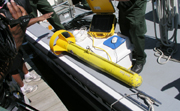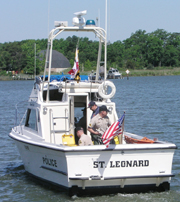  |
||
|
||
Finding Drowned BodiesSide-scan sonar aids in Maryland recoveries
by Alex MurrayThink back on director Jonathan Demme’s The Silence of the Lambs. Envision the discovery of the dead body in the river of Clay County, West Virginia. Imagine that, instead of Hannibal Lector and cannibalism, the movie focused on the recovery of a body lost in the depths. Such a movie would look a lot like the scene that concluded June 19 on the Chesapeake Bay with the discovery of three bodies, including that of Philip Merrill. On June 10, Merrill, chairman of Capital-Gazette Communications Inc., set sail on his 41-foot sailboat, Merrilly. The vessel turned up hours later in Plum Point with no one on board. Nine days later, a boater found Merrill’s body 11.5 miles northwest of the site of his vessel, one mile off the shoreline of Poplar Island. The Maryland Natural Resources Police used side-scan sonar as the principal method for their planned search of 176 square miles — about half the size of Calvert County — of Chesapeake waters. On Saturday, June 17, when sonar searches ceased, 30 square miles had been searched. Common police methods for such vast-area searches can also include bar drags, which scrape the bottom. Cadaver dogs and divers are used to help recover bodies in small areas. At the height of the search for Merrill, three vessels equipped with side-scan sonar, four vessels scanning the surface and uncounted volunteer boaters scoured the waters. Four helicopters added their aerial perspective. “The sonar is being used on the route he routinely traveled,” said Natural Resources Police Sergeant Ken Turner before the body turned up south of the search area and Merrill’s typical route, which encompassed waters from the Severn River to Kent Island. In side-scan sonar searches, the towfish, a yellow sonar device that emits sound waves 90 feet to both the left and right, attaches to a vessel by a black cable ranging from 90 to 600 feet long. From its position behind the boat, the sonar detects objects in the waters and sends pictures to a computer monitor aboard. However, boats can only travel a maximum of 4.5 knots for best resolution, making progress slow. Shipboard images are viewed in real time as well as downloaded for future reference. Aided by GPS technology, police use floats to mark the surface above items of interest for divers to investigate. Corporal Paul Carey briefly demonstrated the side-scan sonar at Sandy Point State Park before returning to search for Merrill’s body aboard the St. Leonard, a police motorboat equipped with the sonar. Natural Resources Police purchased this technology in July 2005 from Marine Sonic Technology Inc. in Virginia for $30,000. “Fish schools, crab pots and oyster bars have shown up,” said Carey, naming a few Bay objects and creatures that typically appear onscreen. Police can also use side-scan sonar for sunken vessels and evidence in criminal cases. “Side-scan sonar is only used when needed,” said Turner. When needed has included three searches this month and as many as three others this year. During the search for Merrill, Natural Resources Police also used side-scan sonar to recover the bodies of John Walker and William Heislip. The men fell overboard from a bass boat in the Potomac River the night of June 16. On June 17, the sonar produced images resembling bodies. Divers went down and recovered the two lost men. In March of this year, 15-year-old Ethan Embree’s canoe capsized in the Elk River. The search comprised an area much smaller than that of Merrill’s, but the murky waters hurt the resolution of the sonar-transmitted images. The teenager’s body surfaced three weeks later. Futuristic as side-scan sonar sounds, it was first used over 40 years ago. The initial side-scan sonar experiments were done in 1963 by Dr. Harold Edgerton at the Massachusetts Institute of Technology to find the sunken Vineyard Lightship in Buzzards Bay, Massachusetts. In 1967, the sonar aided in the find of English King Henry VIII’s long-lost flagship. The original technology produced images on paper rather than a computer screen. Since the 1960s, scientists have developed side-scan sonar into a more sophisticated technology. The present sonar is not foolproof, for it bounces off obstacles such as the pillars of the Bay Bridge, and it proceeds tediously. But when the location is narrowed, as was the case with the two boaters this past weekend, it works well. In the Merrill recovery, technology did not turn up the results that nature uncovered. Even foolproof sonar would have been challenged to find Merrill, due to the vast range of water where his body could have been found. |
||
|
|
||
|
© COPYRIGHT 2004 by New Bay Enterprises, Inc. All rights reserved. |



